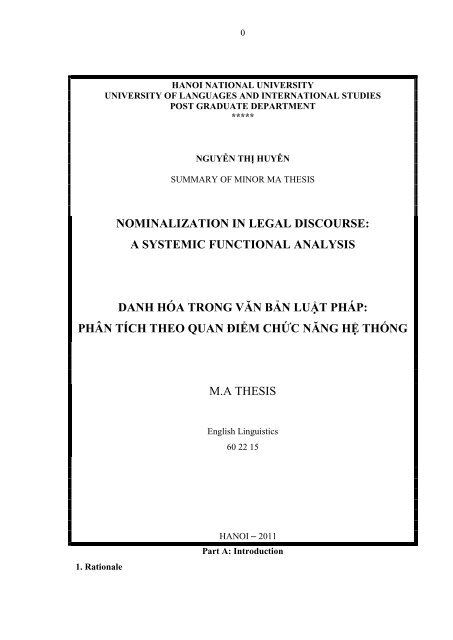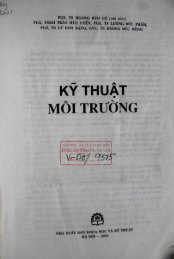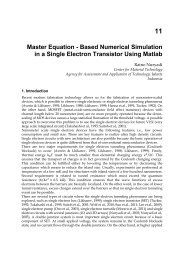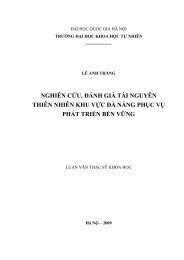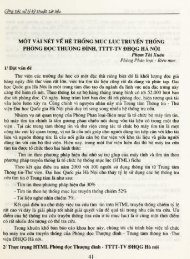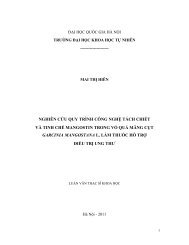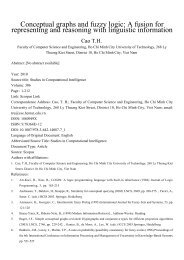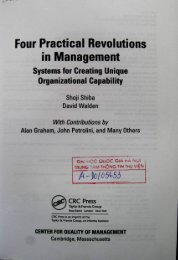NOMINALIZATION IN LEGAL DISCOURSE: A SYSTEMIC ...
NOMINALIZATION IN LEGAL DISCOURSE: A SYSTEMIC ...
NOMINALIZATION IN LEGAL DISCOURSE: A SYSTEMIC ...
Create successful ePaper yourself
Turn your PDF publications into a flip-book with our unique Google optimized e-Paper software.
1<br />
Nominalization is one of the most prominent features of formal written discourses. As one<br />
type of very formal written discourse, English legal discourse is noted for its high<br />
frequency of nominalization. Apart from the roles of nominalization in constructing the<br />
specific characteristics for this genre, nominalization is also one of the grammar structures<br />
causing a higher degree of ambiguity in legal discourses. Therefore, understanding the<br />
nature and characteristics as well as the roles of nominalization in English legal discourse<br />
will make great contribution to the perception of this discourse genre, which is very<br />
necessary in today’s world when globalization and integration has become an inevitable<br />
trend. Thus, it is of great necessity to conduct a study on the phenomenon of<br />
nominalization in legal discourses if we want to learn more about this important variety of<br />
English and benefit the reading and writing of English legal discourses as well as help<br />
translators much easier in translating Vietnamese legal discourses into English and vice<br />
versa. Using the theory of systemic functional grammar which is considered a satisfactory<br />
explanation of the phenomenon of nominalization as developed by Halliday (1994) and<br />
some other systemic linguists, this thesis attempts to explore how nominalization is<br />
realized in English legal discourse with the hope that it will help readers to recognize the<br />
importance of nominalization for the comprehension and manipulation this specific genre.<br />
2. Aims of the study<br />
The aim of the study is to make an inquiry into how nominalization is realized in English<br />
legal discourse. To achieve the aim of the study, the main research question needs to be<br />
raised for exploration is:<br />
How is nominalization realized in English legal discourse?<br />
However, to find the answer for this main question, two following questions must be<br />
investigated first:<br />
1. What is nominalization?<br />
2. What are the main characteristics of English legal discourse?<br />
3. Scope of the study<br />
The scope of this study is just to investigate the typical realization of nominalization in one<br />
genre of English legal discourse - A prescriptive legal text: “Convention on the Rights of<br />
the Child” (1989).<br />
4. Method of the study
2<br />
This is a case study using systemic functional grammar as the theoretical framework. To<br />
achieve the goal of the study, both quantitative and qualitative method will be employed.<br />
1. Grammatical metaphor<br />
Definition<br />
Part B: Development<br />
Chapter 1: Theoretical background<br />
The concept of grammatical metaphor arose from the ancient time by the Ancient Greek<br />
philosopher - Aristotle. For him, metaphor was defined as “one word for a concept used to<br />
refer to another one”. To Halliday (1994), metaphor is also a transference, which uses a<br />
kind of grammar means to replace another, but expresses the same grammatical meaning.<br />
According to Halliday and Martin (1993: 79) cited in Wang (2002), a grammatical<br />
metaphor (GM) is a substitution of one grammatical class, or one grammatical structure, by<br />
another. Thompson (1996) defined grammatical metaphor as the expression of a meaning<br />
through a lexical-grammatical form which originally evolved to express a different kind of<br />
meaning.<br />
1.2. Types<br />
Halliday (1994: 343) classifies grammatical metaphor into two main types: metaphors of<br />
mood (including modality) and metaphors of transitivity. In terms of model of semantic<br />
functions, these are, respectively, interpersonal metaphors and ideational metaphor.<br />
When classifying grammatical metaphor, Martin (1992) divided it into ideational (logical<br />
and experiential), interpersonal and textual metaphor. In this thesis, Halliday’s view in<br />
classifying grammatical will be adopted.<br />
2.1. Definition<br />
Chapter 2: Nominalization: A general description<br />
Scholars from different linguistic schools present different points of view toward<br />
nominalization. According to Quirk (Quirk et al. 1985), nominalization is a process of<br />
turning a verb or an adjective into a noun. In a somewhat similar manner, nominalization is<br />
defined as the grammatical process of forming nouns from other parts of speech, usually<br />
verbs or adjectives (Longman Dictionary of Language Teaching and Applied Linguistics,
3<br />
2002). Chomsky (1968) believes that “nominalization is a process by which a stem, verb<br />
phrase or sentence is transformed into a nominal”.<br />
Thompson (1996: 167) argues that “nominalization is the use of a nominal form to express<br />
a process meaning”. He adds that “nominalization can also be used to express an<br />
attributive meaning – a relational process together with the Attribute”. To Mathews (1997),<br />
nominalization is “any process by which either a noun or a syntactic unit functioning as a<br />
noun phrase is derived from any other kind of unit”. As one of the most famous systemic<br />
linguists, Halliday (1985) points out that nominalization refers to any element or group that<br />
can function as nouns or noun groups in a clause, including clauses, nominalized adjectives<br />
or verbs, etc.<br />
2.2. Functions<br />
- One important function of nominalization in encapsulation. By “nouning” a process, the<br />
writer can reflect a fact that he has negotiated and established the meaning of the clause<br />
centred around the process – in other words, that meaning can now be treated as existing,<br />
as a kind of abstract “thing”. It makes it possible to develop an argument step by step,<br />
using complex passages “packaged” in nominal form as Theme.<br />
- Nominalization helps create the sense of objectivity for the text. Nominalization is used<br />
for ideological control as a “masking device” for they allow the withholding of the identity<br />
of the actors. It not only obscures the participants but also the time, space and modality to<br />
make the expression more objective and non-negotiable.<br />
- Nominalization can add another semantic dimension to what already exists in the<br />
congruent form. According to Halliday (1994: 353), the piece of wording that is<br />
metaphorical has as it were an additional dimension of meaning: it means both<br />
metaphorically and congruently.<br />
- The use of nominalization has changed people's perception of the world, or the world of<br />
experiences. Nominalization is a tool used to name things in certain forms in different<br />
ways, as though the identities have been transformed into different things.<br />
- Nominalization makes the text more ambiguous. In a text packed with nominalizations,<br />
when clausal patterns or congruent forms are replaced by nominalized ones, some of the<br />
information is lost. The writer presumably knows exactly what they mean; but the reader
5<br />
clauses are finite complement clauses; to-clauses and ing-clauses are non-finite<br />
complement clauses.<br />
2.3.2.1. That-clauses<br />
That-clauses are finite. Therefore, they are marked for tense and modality, and they have a<br />
subject. For example: “I think Stuart’s gone a bit mad.”<br />
2.3.2.2. Wh-clauses<br />
There are three basic types of wh- complement clauses: Interrogative clauses, nominal<br />
relative clauses and exclamatives. For example: “Jill was asking what happened.”<br />
2.3.2.3. To-clauses<br />
Eg: I am trying to get away early.<br />
2.4.2.4. Ing-clauses<br />
Eg: I remember reading this book.<br />
Chapter 3: Realization of nominalization in legal discourse: Convention on the rights<br />
of the child<br />
3.1. English legal discourse<br />
3.1.1. Clasification<br />
Sarcevie (2000: 9) cited in William (2007: 28) divides written legal discourse into three<br />
main types: prescriptive, descriptive and hybrid legal texts.<br />
3.1.2. Characteristics of English legal discourse<br />
The main linguistic features of English legal discourse will be summarized in terms of<br />
lexical, syntactic and textual features.<br />
3.1.2.1. Lexical characteristics<br />
Ø Technical vocabulary<br />
Ø Use of modal verbs to establish rights and obligations<br />
Ø Archaic or rarely used words and expressions<br />
Ø Foreign words and expressions, especially Latinisms<br />
3.2.2.2. Grammatical characteristics<br />
Ø Nominalization<br />
Ø Binominal and multinominal features
Ø Complex prepositional phrases<br />
Ø Lengthy and complex sentences<br />
Ø Syntactic discontinuity<br />
Ø Frequent use of passive constructions<br />
Ø Impersonal constructions<br />
3.2.2.3. Textual characteristics<br />
Ø Repetition of particular words, expressions and syntactic structures<br />
Ø Use of anaphoric and cataphoric reference<br />
6<br />
3.3. Realization of nominalization in prescriptive legal text “Convention on the Rights<br />
of the Child”<br />
3.3.1. Frequency of occurance of nominalization<br />
The ratio between the total number of nominalized processes and the total number of<br />
words in the text is defined as the frequency of occurrence of nominalization. In legal text<br />
“Convention on the rights of the child”, out of 7561 words, nominalization occurs 748<br />
times. It means that nominalization occurs approximately once every 10 words. This is a<br />
very high ratio in comparison with that of some other genres such as news reports (once<br />
every 19 words). The frequency of nominalization in the sample legal text explains why<br />
this genre is highly condensed, and really difficult to understand. It can be concluded that<br />
nominalization is prevail in English legal discourse and is considered a prominent<br />
characteristic for this type of discourse<br />
3.3.2. Typical types and characteristics of nominalization<br />
3.3.2.1. Typical types<br />
Basing on classification of types of nominalization presented in the previous section, we<br />
have found that in English legal discourse, there exist all types of nominalization with the<br />
transition from process, clause or attribute… into Thing. However, nominalization is<br />
created mostly by the drift from process with 75.4% into Thing and the most frequently<br />
used form of nominalization is the category of deverbal nominalization which makes up<br />
for 53.9%. Ranking second is clausal nominalization with 15.9% in which To-clause has<br />
the highest percentage with 7.6%. Deadjectival nominalization with the drift from attribute<br />
and quality into Thing only accounts for 8.7% ranking at the last position.<br />
By using nominalization instead of processes, it makes the overt processes disappear and<br />
more often than not, the actors of the processes are invisible. Thus, by using
7<br />
nominalization, writer can obscure not only the participants but also the time, the space,<br />
and the modality to help the utterance achieve the sense of objectivity and non-<br />
negotiability.<br />
3.3.2.2. Characterisitcs of nominalization<br />
- The most frequent type of nominalization used in this legal text is deverbal<br />
nominalization in which the most typical suffixes can be found are “ion” which occurs 99<br />
times such as foundation, protection, provision, adoption, discrimination, consideration,<br />
implementation…and “ment” which occurs 65 times such as development, punishment,<br />
imprisonment, agreement, involvement, enjoyment…. The suffixes “ion” and “ment” refer<br />
to the state, action or instance of verbs, which indicates either the process of making or<br />
doing. The states, process or instances are what legal discourse takes best advantage of,<br />
and that explains the high frequency of suffixes “ion” and “ment” used in this legal text.<br />
- Nominalized processes are used continuously in parallel, which makes the text more<br />
convincing and strong. It intensifies the tempo for this legal text and makes it full of<br />
power. If congruent forms were chosen as an alternative, there would be more subjects and<br />
predicates, as well as losing the effect of parallelism. For example,<br />
(1) States Parties shall take all appropriate measures to promote physical and<br />
psychological recovery and social reintegration of a child victim of: any form of neglect,<br />
exploitation, or abuse; torture …..(line 498-500).<br />
- There are some nominalization which are repeated throughout this legal text such as care<br />
(27 times), protection (18 times), development (18 times), assistance (17 times), need (13<br />
times), freedom (15 times) and responsibility (8 times)…Basing on the frequent use of the<br />
nominalization above, the ideology of the whole text is revealed - that is responsibility of<br />
all States Parties to ensure the basic rights of the child so that all children can live in care,<br />
freedom, protection, assistance…<br />
3.3.3. Semantic roles of nominalization realized in terms of ideational, interpersonal,<br />
and textual metafunction<br />
3.3.3.1. In terms of ideational metafunction<br />
When a process, a clause or an attribute are transferred into Thing, they can play different<br />
roles in a clause. Nominalization can be or a constituent of goal, circumstance, qualifier, or
8<br />
identifier… Different role of nominalization in a clause will reveal different functions for<br />
the text. In terms of ideational metafunction, nominalization mostly plays the role of goal<br />
in a clause with 29.5%. Circumstance and qualifier rank second and third with 26.5% and<br />
24.7% respectively. According to Halliday (1994: 110), material process is the process of<br />
“doing”. They express the notion that some entity “does” something – which may be done<br />
“to” some other entity. The term goal implies “directed at”. Legal discourse often directs<br />
what people must or must not do something or something must or must not be done. The<br />
text - “Convention on the right of the child” is an international convention in which all the<br />
States Parties signed in this convention have to obey and follow some rules to protect the<br />
child. Thus, “States Parties” mostly plays the role of actors in material processes<br />
throughout the text. In this legal text, most of nominalization is realized in goal and it is<br />
what the actor must direct at. The frequent use of circumstances and especially qualifiers<br />
makes this legal text lengthier and more complex. This is also a prominent characteristic of<br />
legal discourse, which explains why understanding legal discourses seem to be very<br />
challenging to almost all of the readers.<br />
3.3.3.2. In terms of interpersonal metafunction<br />
In terms of interpersonal metafunction, mostly nominalization is realized as complement<br />
with 271 times of occurrence accounting for 51.5% - nearly half of the total. Adjunct ranks<br />
second with 37.7% and 10.9% is the percentage of subject.<br />
According to Halliday & Matthiessen (2004: 122-123), a complement is an element within<br />
the residue that has the potential of being subject but is not; in other words, it is an element<br />
that has the potential for being given the interpersonally elevated status of modal<br />
responsibility - something that can be the nub of the argument and it is typically realized<br />
by a nominal group. For example,<br />
States Parties recognize the rights of the<br />
child…assembly.<br />
TRANS. Actor Process: meterial goal<br />
MOOD Subject Finite (present) Predicator Complement<br />
Mood Residue<br />
3.3.3.3. In terms of texutal metafunction<br />
(Line 155, 156)
9<br />
a large amount of nominalization (87.6%) is founded in rheme in terms of textual<br />
metafunction. Theme is the starting point for the message - the element which the clause is<br />
going to be ‘about’ and realized by whatever element comes first. Rheme is the rest of the<br />
message, which provides the additional information added to the starting point and which<br />
is available for subsequent development in the text (Halliday, 1994). Rheme often carries<br />
new information, which needs to be judged by readers. However, by using nominalization<br />
in rheme, the new information becomes something abstract and non-negotiable, which<br />
helps create a sense of power and authority for legal discourse. With a very large amount<br />
of nominalization realized as rheme in this legal text, it can make the text more<br />
authoritative and powerful. For example,<br />
States Parties / recognize the rights of the child to freedom of association and to freedom<br />
Theme Rheme<br />
of peaceful assembly. (line 186,187)<br />
In the example above, when being realized in rheme, “freedom of association” and<br />
“freedom of peaceful assembly” become undeniable right of children – something that is<br />
non-negotiable and already admitted by all readers.<br />
Part C: Conclusion<br />
1. Recapitulation<br />
It can be said that nominalization is a prominent feature in legal discourses. It occurs about<br />
once every 10 words. Results show that nominalization is created mostly by the drift from<br />
process with into Thing with the most frequently used form is the category of deverbal<br />
nominalization. Because of a large amount of nominalization realized as goal, complement<br />
and rheme in terms of ideational, interpersonal and textual metafunctions, nominalization<br />
can make the text more lengthy, complex, objective, concise, authoritative, and cohesive<br />
2. Implications<br />
2.1. To teachers<br />
Teachers should remind students of these things and provide them with necessary<br />
knowledge of nominalization and legal discourses so that students can develop greater<br />
autonomy to comprehend and manipulate this genre.
10<br />
In addition, knowledge of nominalization proves effective in helping students develop their<br />
arguments in writing tasks. Function of nominalization provides a means of building up the<br />
objectivity, conciseness, descriptive potential and cohesiveness in written texts. Therefore,<br />
nominalization should be taken into consideration in developing writing material for<br />
students.<br />
2.2. To translators<br />
As can be seen from the study, the more nominalization existing in the text, the more<br />
complicated and ambiguous that text is. In other words, nominalization creates maximum<br />
distance between technical knowledge and the experience of daily life. Thus, translating<br />
legal discourses is always a big challenge to all the translators. As the results, an insight<br />
into the nature of nominalization in English legal discourse will certainly help translators<br />
solve problems that may occur when they decode a legal discourse and encode it into a<br />
translated version in the target language.<br />
3. Limitations and suggestions for further studies<br />
First of all, this study aims to make both a qualitative and quantitative study on the<br />
phenomenon of nominalization in legal discourses. Although the author tries the<br />
quantitative method, the data used in the study is still limited. If possible, the further<br />
studies should make the use of corpus to enrich the data and thus, make the study more<br />
reliable.<br />
Secondly, nominalization also bounds in Vietnamese legal discourses. Thus, the next<br />
studies should explore the similarities and differences between English legal discourses<br />
and Vietnamese ones. This will be of great significance to Vietnamese linguists, lawyers,<br />
teachers and students especially ones majoring in law in understanding and translating<br />
legal documents.<br />
Besides, since the focus of the study is on the phenomenon of nominalization in legal<br />
discourses. Therefore, further studies of nominalization in other genres such as journalism<br />
or advertising would be of great value.


